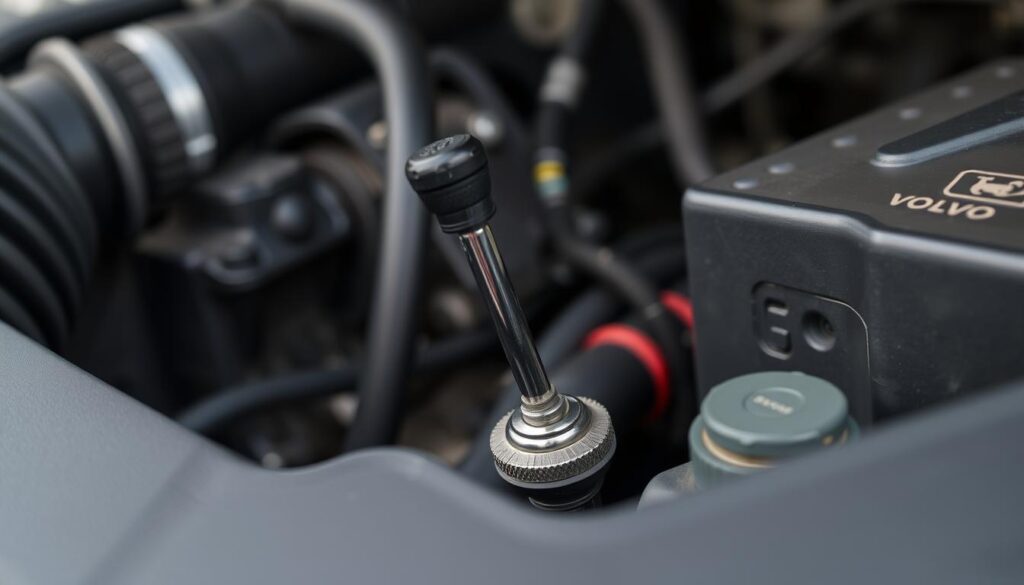Maintaining your Volvo’s transmission is crucial for its overall performance and longevity. One key aspect of this maintenance is checking the transmission fluid. The transmission fluid plays a vital role in lubricating the transmission’s components, ensuring smooth gear shifts, and regulating temperature.
If you’re experiencing issues like a gear shift getting stuck in neutral, it might be a sign that your transmission fluid level is low, as highlighted in this article on Volvo gear shift issues. Regularly checking your Volvo’s transmission fluid can help prevent such problems.
Key Takeaways
- Regular transmission fluid checks can prevent gear shift issues.
- Low transmission fluid levels can cause gears to grind and slip.
- Maintaining the appropriate fluid level is crucial for transmission health.
- A clogged transmission filter can lead to low pressure and sticky gears.
- Checking transmission fluid is a simple process that can be done at home.
Why Regular Transmission Fluid Checks Matter for Your Volvo
Regular transmission fluid checks are crucial for maintaining the health of your Volvo’s transmission system. Transmission fluid plays a vital role in lubricating the transmission’s components, regulating temperature, and facilitating smooth gear shifts.
Signs of Low or Degraded Transmission Fluid
Low or degraded transmission fluid can lead to serious issues with your Volvo’s transmission. Signs of low transmission fluid include slipping or hesitation between gears, unusual noises, and a burning smell.
Performance Symptoms to Watch For
Performance issues such as delayed acceleration or rough shifting can indicate low or degraded transmission fluid. If you notice any of these symptoms, it’s essential to check your transmission fluid level promptly.
Warning Lights and Indicators
Modern Volvos are equipped with sophisticated warning systems. If the transmission warning light illuminates on your dashboard, it could be a sign that your transmission fluid level is low or there’s an issue with the transmission.
How Often to Check Your Volvo’s Transmission Fluid
The frequency of transmission fluid checks depends on your Volvo’s model and age. Generally, it’s recommended to check the transmission fluid every 30,000 to 60,000 miles. However, it’s best to consult your owner’s manual for specific guidance.
| Volvo Model | Recommended Check Interval |
|---|---|
| Volvo S60 | 30,000 miles |
| Volvo XC90 | 50,000 miles |
Tools and Materials You’ll Need
Gathering the correct tools for checking transmission fluid is a crucial step in checking your Volvo’s transmission fluid. Having the right equipment ensures that the process is done efficiently and accurately.
Essential Tools for Checking Transmission Fluid
The essential tool for checking transmission fluid is the transmission dipstick. Most Volvo models come equipped with a dipstick for this purpose. You’ll also need a lint-free rag or paper towels to wipe the dipstick clean. It’s crucial to use a lint-free material to prevent any debris from contaminating the transmission fluid.
Optional Equipment for a More Thorough Check
For a more thorough check, you may want to use a transmission fluid check kit, which can include a fluid tester and other diagnostic tools. Additionally, having a funnel on hand can be useful if you need to top off the transmission fluid.
Preparing Your Volvo for a Transmission Fluid Check
Preparing your Volvo for a transmission fluid check involves several crucial steps that ensure your safety and the accuracy of the results. Before you begin, it’s essential to understand the importance of each step in the process.
Finding the Right Location
To check your Volvo’s transmission fluid, you need to park on a level surface. This ensures that the fluid level reading is accurate. Choose a flat and stable location, away from any inclines or declines.
Engine Temperature Considerations
The engine temperature plays a significant role in checking the transmission fluid. It’s recommended to check the fluid when the engine is warm, as this provides a more accurate reading. Drive your Volvo for a few minutes before checking the fluid to warm up the engine.
“Always refer to your owner’s manual for specific guidelines on checking transmission fluid in your Volvo model.”
Safety Precautions to Take
When checking your Volvo’s transmission fluid, safety should be your top priority. Ensure the vehicle is in park and apply the parking brake. Additionally, be cautious of the hot engine and surrounding components to avoid any burns or injuries.
| Safety Precaution | Description |
|---|---|
| Parking Brake | Engage the parking brake to ensure the vehicle remains stationary. |
| Engine Temperature | Be aware of the engine temperature to avoid burns. |
| Transmission Dipstick | Handle the transmission dipstick with care, as it may be hot. |
By following these steps and taking the necessary safety precautions, you can ensure a safe and accurate transmission fluid check for your Volvo.
How to Check Volvo Transmission Fluid: Step-by-Step Guide
To ensure your Volvo runs smoothly, it’s essential to know how to check its transmission fluid. Regular checks can help identify potential issues before they become major problems, saving you time and money in the long run.
Locating the Transmission Dipstick in Different Volvo Models
The transmission dipstick location varies across different Volvo models. Understanding where to find it in your specific vehicle is crucial for an accurate check.
Dipstick Locations in Older Volvo Models (S60, V70, XC90)
In older models like the S60, V70, and XC90, the transmission dipstick is typically located near the engine and is labeled for easy identification. For more detailed information, you can refer to resources like Volvo transmission FAQs.

Newer Volvo models, such as the S90, XC60, and XC40, may have the transmission dipstick located in a different position or may not have one at all if they feature a sealed transmission system. For these models, it’s crucial to consult your owner’s manual or contact a dealership for guidance.
Proper Technique for Reading Fluid Levels
Once you’ve located the transmission dipstick, the next step is to understand how to read the fluid level correctly. Ensure your vehicle is on a level surface and the engine is running. Pull out the dipstick, wipe it clean, and then insert it back into the transmission fluid reservoir before pulling it out again to check the level.
The fluid level should be between the minimum and maximum marks on the dipstick. If it’s below the minimum, you need to add the appropriate type of transmission fluid. It’s also important to check the fluid’s condition; it should be pink or red and not have a burnt smell.
Interpreting the Results
After checking the fluid level and condition, you’ll need to interpret the results. If the level is low, topping it off with the correct type of transmission fluid is necessary. If the fluid is dirty or has a burnt smell, it may be a sign that the transmission is experiencing problems, and you should consider having it inspected by a professional.
Regularly checking your Volvo’s transmission fluid can help maintain its health and performance. By following these steps and understanding what to look for, you can ensure your vehicle continues to run smoothly.
Assessing Transmission Fluid Quality and Condition
Assessing the transmission fluid’s quality and condition is a vital step in ensuring the longevity of your Volvo’s transmission. The transmission fluid plays a crucial role in lubricating the transmission components, regulating temperature, and facilitating smooth gear shifts.
Normal vs. Abnormal Fluid Color and Smell
The color and smell of the transmission fluid can indicate its condition. Healthy transmission fluid is typically a light brown or pink color, depending on the type of fluid used.
What Healthy Transmission Fluid Looks Like
Healthy transmission fluid should be clear and free of debris. If the fluid is dark or black, it may be a sign that it’s degraded or contaminated.
Warning Signs in Fluid Appearance
Abnormal fluid color or smell can indicate potential problems. For instance, a burnt smell may suggest overheating, while a milky appearance could indicate coolant contamination.
Identifying Contaminants and Problems
Checking for contaminants is crucial. Particles or debris in the fluid can signify wear and tear on the transmission components. Regular checks can help identify issues before they become major problems.
By regularly assessing the transmission fluid’s quality and condition, you can help ensure the longevity and health of your Volvo’s transmission system.
Modern Volvo Models with Electronic Transmission Systems
The advent of electronic transmission systems in newer Volvo models has revolutionized transmission maintenance. These advanced systems have changed how owners check transmission fluid, making traditional methods obsolete in some cases.

Modern Volvo models equipped with electronic transmission systems often lack traditional dipsticks, complicating the process of checking transmission fluid levels.
Checking Fluid in Dipstick-less Transmissions
In Volvo models without a dipstick, checking transmission fluid involves more than just looking at a dipstick. Some models may have a dedicated transmission fluid level sensor, while others might require a different approach.
For dipstick-less transmissions, it’s essential to consult the owner’s manual or a professional mechanic to determine the best method for checking fluid levels.
Using Volvo’s On-Board Diagnostics
Volvo’s on-board diagnostics (OBD) system provides valuable insights into the transmission’s health. By using an OBD-II scanner, owners can access trouble codes and monitor transmission performance.
This diagnostic capability allows for early detection of potential issues, helping to prevent costly repairs down the line.
Topping Off Your Volvo’s Transmission Fluid
To keep your Volvo’s transmission in top condition, it’s essential to understand how to properly top off the transmission fluid. This process involves selecting the correct type of transmission fluid and using the proper filling technique to avoid any potential issues.
Selecting the Correct Transmission Fluid Type
Choosing the right transmission fluid for your Volvo is critical. Different models may require different types of fluid, so it’s crucial to consult your owner’s manual or manufacturer’s guidelines.
Recommended Fluids for Different Volvo Models
Various Volvo models may specify different transmission fluids. For instance, some models may require synthetic fluid, while others may use conventional fluid. Always check your owner’s manual for the recommended fluid type.
OEM vs. Aftermarket Options
When it comes to transmission fluid, you have the option of choosing between Original Equipment Manufacturer (OEM) and aftermarket fluids. OEM fluids are designed to meet the manufacturer’s specifications, while aftermarket fluids may offer similar quality at a different price point.
Proper Filling Technique
Once you’ve selected the correct transmission fluid, the next step is to properly fill your Volvo’s transmission. This involves locating the transmission dipstick or fill port, depending on your Volvo model, and slowly pouring in the fluid while checking the level.
Key steps to follow:
- Locate the transmission dipstick or fill port as specified in your owner’s manual.
- Use a funnel to pour in the transmission fluid to avoid spills.
- Add fluid gradually, checking the level frequently to avoid overfilling.
- Replace the dipstick or cap securely after checking the level.
By following these guidelines and using the correct materials, you can ensure that your Volvo’s transmission remains well-lubricated and functions smoothly.
Conclusion
Regularly checking your Volvo’s transmission fluid is crucial for the longevity and health of your vehicle. As discussed, understanding how to check Volvo transmission fluid and maintaining the transmission system can prevent costly repairs and ensure smooth performance.
By following the steps outlined, you can easily check your Volvo’s transmission fluid and stay on top of Volvo transmission maintenance. This simple process helps identify potential issues early, allowing for timely interventions that can significantly extend the life of your vehicle’s transmission.
Remember, a well-maintained transmission is key to the overall performance and durability of your Volvo. Make transmission fluid checks a part of your regular vehicle maintenance routine to keep your Volvo running smoothly for years to come.
FAQ
How often should I check my Volvo’s transmission fluid?
It’s recommended to check your Volvo’s transmission fluid every 30,000 to 50,000 miles, or as specified in your owner’s manual. Regular checks can help identify potential issues before they become major problems.
What are the signs of low or degraded transmission fluid in my Volvo?
Signs of low or degraded transmission fluid include slipping or hesitation between gears, unusual noises, and warning lights on your dashboard. You may also notice a burning smell or dark, dirty fluid.
Can I check my Volvo’s transmission fluid myself?
Yes, you can check your Volvo’s transmission fluid yourself by following the steps outlined in your owner’s manual or by consulting a professional mechanic. Make sure to use the correct procedures and safety precautions.
What type of transmission fluid should I use in my Volvo?
The type of transmission fluid to use in your Volvo depends on the model and year of your vehicle. Consult your owner’s manual or contact a Volvo dealership or certified mechanic to determine the recommended fluid type.
How do I know if my Volvo has a dipstick-less transmission?
If your Volvo is a newer model (S90, XC60, XC40, etc.), it may have a dipstick-less transmission. Consult your owner’s manual or contact a Volvo dealership or certified mechanic to determine if your vehicle has a sealed transmission.
Can I use aftermarket transmission fluid in my Volvo?
While OEM transmission fluid is recommended, some aftermarket fluids may be compatible with your Volvo. However, it’s essential to consult your owner’s manual or contact a Volvo dealership or certified mechanic to ensure the fluid meets the manufacturer’s specifications.
What are the consequences of neglecting transmission fluid checks?
Neglecting transmission fluid checks can lead to premature wear, damage, or even failure of your Volvo’s transmission. Regular checks can help prevent costly repairs and ensure the longevity of your vehicle.
Can I check my Volvo’s transmission fluid when the engine is cold?
It’s generally recommended to check your Volvo’s transmission fluid when the engine is warm, as this provides a more accurate reading. However, consult your owner’s manual for specific guidance on checking transmission fluid in your vehicle.



